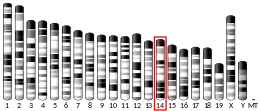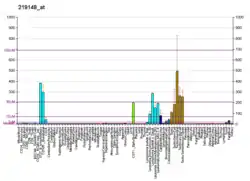PBK (gene)
Lymphokine-activated killer T-cell-originated protein kinase is an enzyme that in humans is encoded by the PBK gene.[5][6][7]
The protein encoded by this gene is a serine/threonine kinase related to the dual specific mitogen-activated protein kinase kinase (MAPKK) family. Evidence suggests that mitotic phosphorylation is required for its catalytic activity. This mitotic kinase may be involved in the activation of lymphoid cells and support testicular functions, with a suggested role in the process of spermatogenesis.[7]
References
- GRCh38: Ensembl release 89: 55872 - Ensembl, May 2017
- GRCm38: Ensembl release 89: ENSMUSG00000022033 - Ensembl, May 2017
- "Human PubMed Reference:". National Center for Biotechnology Information, U.S. National Library of Medicine.
- "Mouse PubMed Reference:". National Center for Biotechnology Information, U.S. National Library of Medicine.
- Abe Y, Matsumoto S, Kito K, Ueda N (Aug 2000). "Cloning and expression of a novel MAPKK-like protein kinase, lymphokine-activated killer T-cell-originated protein kinase, specifically expressed in the testis and activated lymphoid cells". J Biol Chem. 275 (28): 21525–31. doi:10.1074/jbc.M909629199. PMID 10781613.
- Gaudet S, Branton D, Lue RA (Jun 2000). "Characterization of PDZ-binding kinase, a mitotic kinase". Proc Natl Acad Sci U S A. 97 (10): 5167–72. Bibcode:2000PNAS...97.5167G. doi:10.1073/pnas.090102397. PMC 25800. PMID 10779557.
- "Entrez Gene: PBK PDZ binding kinase".
Further reading
- Zhao S, Dai J, Zhao W, et al. (2001). "PDZ-binding kinase participates in spermatogenesis". Int. J. Biochem. Cell Biol. 33 (6): 631–6. doi:10.1016/S1357-2725(01)00005-X. PMID 11378444.
- Simons-Evelyn M, Bailey-Dell K, Toretsky JA, et al. (2003). "PBK/TOPK is a novel mitotic kinase which is upregulated in Burkitt's lymphoma and other highly proliferative malignant cells". Blood Cells Mol. Dis. 27 (5): 825–9. doi:10.1006/bcmd.2001.0452. PMID 11783945.
- Strausberg RL, Feingold EA, Grouse LH, et al. (2003). "Generation and initial analysis of more than 15,000 full-length human and mouse cDNA sequences". Proc. Natl. Acad. Sci. U.S.A. 99 (26): 16899–903. Bibcode:2002PNAS...9916899M. doi:10.1073/pnas.242603899. PMC 139241. PMID 12477932.
- Yuryev A, Wennogle LP (2003). "Novel raf kinase protein-protein interactions found by an exhaustive yeast two-hybrid analysis". Genomics. 81 (2): 112–25. doi:10.1016/S0888-7543(02)00008-3. PMID 12620389.
- Ota T, Suzuki Y, Nishikawa T, et al. (2004). "Complete sequencing and characterization of 21,243 full-length human cDNAs". Nat. Genet. 36 (1): 40–5. doi:10.1038/ng1285. PMID 14702039.
- Nandi A, Tidwell M, Karp J, Rapoport AP (2004). "Protein expression of PDZ-binding kinase is up-regulated in hematologic malignancies and strongly down-regulated during terminal differentiation of HL-60 leukemic cells". Blood Cells Mol. Dis. 32 (1): 240–5. doi:10.1016/j.bcmd.2003.10.004. PMID 14757441.
- Gerhard DS, Wagner L, Feingold EA, et al. (2004). "The status, quality, and expansion of the NIH full-length cDNA project: the Mammalian Gene Collection (MGC)". Genome Res. 14 (10B): 2121–7. doi:10.1101/gr.2596504. PMC 528928. PMID 15489334.
- Matsumoto S, Abe Y, Fujibuchi T, et al. (2005). "Characterization of a MAPKK-like protein kinase TOPK". Biochem. Biophys. Res. Commun. 325 (3): 997–1004. doi:10.1016/j.bbrc.2004.10.133. PMID 15541388.
- Sabio G, Arthur JS, Kuma Y, et al. (2005). "p38gamma regulates the localisation of SAP97 in the cytoskeleton by modulating its interaction with GKAP". EMBO J. 24 (6): 1134–45. doi:10.1038/sj.emboj.7600578. PMC 556394. PMID 15729360.
- Barrios-Rodiles M, Brown KR, Ozdamar B, et al. (2005). "High-throughput mapping of a dynamic signaling network in mammalian cells". Science. 307 (5715): 1621–5. Bibcode:2005Sci...307.1621B. doi:10.1126/science.1105776. PMID 15761153. S2CID 39457788.
- Kim J, Bhinge AA, Morgan XC, Iyer VR (2005). "Mapping DNA-protein interactions in large genomes by sequence tag analysis of genomic enrichment". Nat. Methods. 2 (1): 47–53. doi:10.1038/nmeth726. PMID 15782160. S2CID 6135437.
- Stelzl U, Worm U, Lalowski M, et al. (2005). "A human protein-protein interaction network: a resource for annotating the proteome". Cell. 122 (6): 957–68. doi:10.1016/j.cell.2005.08.029. hdl:11858/00-001M-0000-0010-8592-0. PMID 16169070. S2CID 8235923.
- Rual JF, Venkatesan K, Hao T, et al. (2005). "Towards a proteome-scale map of the human protein-protein interaction network". Nature. 437 (7062): 1173–8. Bibcode:2005Natur.437.1173R. doi:10.1038/nature04209. PMID 16189514. S2CID 4427026.
- Dougherty JD, Garcia AD, Nakano I, et al. (2006). "PBK/TOPK, a proliferating neural progenitor-specific mitogen-activated protein kinase kinase". J. Neurosci. 25 (46): 10773–85. doi:10.1523/JNEUROSCI.3207-05.2005. PMC 6725850. PMID 16291951.
- Olsen JV, Blagoev B, Gnad F, et al. (2006). "Global, in vivo, and site-specific phosphorylation dynamics in signaling networks". Cell. 127 (3): 635–48. doi:10.1016/j.cell.2006.09.026. PMID 17081983. S2CID 7827573.
- Nandi AK, Ford T, Fleksher D, et al. (2007). "Attenuation of DNA damage checkpoint by PBK, a novel mitotic kinase, involves protein-protein interaction with tumor suppressor p53". Biochem. Biophys. Res. Commun. 358 (1): 181–8. doi:10.1016/j.bbrc.2007.04.125. PMID 17482142.
- Oh SM, Zhu F, Cho YY, et al. (2007). "T-lymphokine-activated killer cell-originated protein kinase functions as a positive regulator of c-Jun-NH2-kinase 1 signaling and H-Ras-induced cell transformation". Cancer Res. 67 (11): 5186–94. doi:10.1158/0008-5472.CAN-06-4506. PMID 17545598.
- Zhu F, Zykova TA, Kang BS, et al. (2007). "Bidirectional signals transduced by TOPK-ERK interaction increase tumorigenesis of HCT116 colorectal cancer cells". Gastroenterology. 133 (1): 219–31. doi:10.1053/j.gastro.2007.04.048. PMID 17631144.
External links
This article is issued from Wikipedia. The text is licensed under Creative Commons - Attribution - Sharealike. Additional terms may apply for the media files.




